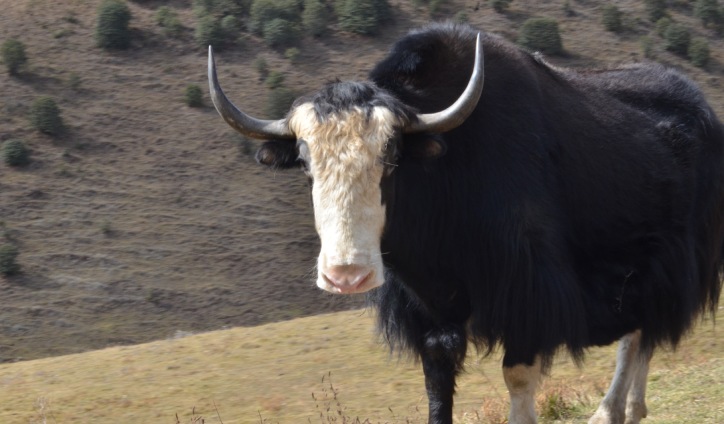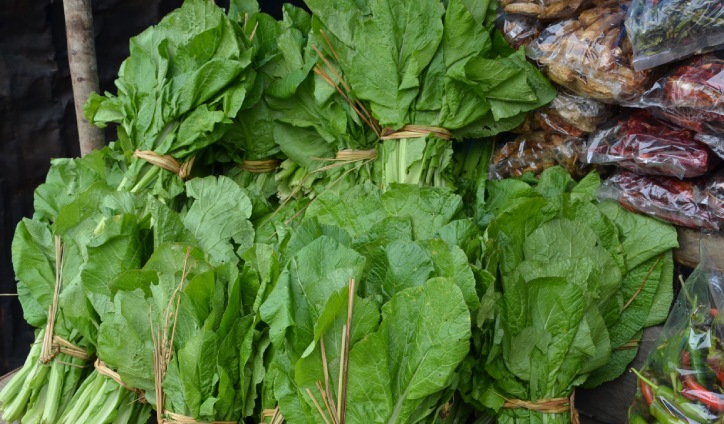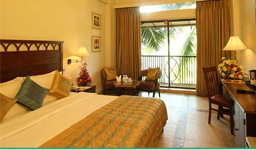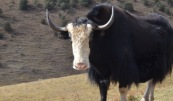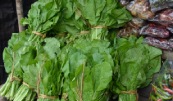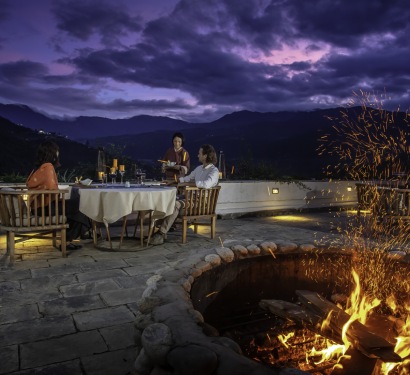Bhutan - Offbeat Nature - 9N10D
Theme: Offbeat Nature
Experiences you will have: Water bodies or sports, Pure nature, Soft trekking, Wildlife, Local food, Visit to monasteries, Mountains
Destination: Bhutan.
Location in brief: Bhutan is a small neighbouring country of India.
Accommodation type: 3 Star, Village/Eco lodge.
Suitable Group size: Any
Check in 2:00 PM | Check out 11:00 AM
Food: Continental, Ethnic Local, Indian.
Hygiene: Maintained as per the laid down protocol and norms.
Terrain: Hilly.
Vehicle provided: Private. As per the request or pre-determined itinerary.
Climate: In the winter season, the high altitude points are covered with snow. At the foothills the climate is cool and bearable. Summer (March to June) is the best season to visit as temperature is pleasant. Visiting in monsoon is a treat for eyes because of greenery and misty air and crowd is also very less.
Check out here:
Experiences you will have: Water bodies or sports, Pure nature, Soft trekking, Wildlife, Local food, Visit to monasteries, Mountains
Destination: Bhutan.
Location in brief: Bhutan is a small neighbouring country of India.
Accommodation type: 3 Star, Village/Eco lodge.
Suitable Group size: Any
Check in 2:00 PM | Check out 11:00 AM
Food: Continental, Ethnic Local, Indian.
Hygiene: Maintained as per the laid down protocol and norms.
Terrain: Hilly.
Vehicle provided: Private. As per the request or pre-determined itinerary.
Climate: In the winter season, the high altitude points are covered with snow. At the foothills the climate is cool and bearable. Summer (March to June) is the best season to visit as temperature is pleasant. Visiting in monsoon is a treat for eyes because of greenery and misty air and crowd is also very less.
Check out here:
Experience breath-taking natural beauty at diverse places and also rich culture of Bhutan – The Land of Thunder Dragon. SAMSONA GETAWAYS, ensures that you not only see but feel the joy of what this mysterious land offers! Beautiful locales, moderately adventurous trails and a flavor of the local life and tastes. This package takes you to the areas which are less frequented. You develop a lot of proximity to nature.
How to reach: Paro is the only International airport in Bhutan. Paro is connected to Kolkata and Delhi very conveniently. Mumbai-Paro flights are operational for limited period.
Bhutan is accessible by road as well. One can catch a flight to Bagdogra airport and then drive to Jaigaon 2:15 hours away which is a border town. From Jaigaon one can enter Phuensholling which is a border town from Bhutan side. From there one can reach Thimphu – capital of Bhutan – in 5:30 hours by road.
Central Bhutan and other main cities in Bhutan are connected by domestic flights.
Bhutan is accessible by road as well. One can catch a flight to Bagdogra airport and then drive to Jaigaon 2:15 hours away which is a border town. From Jaigaon one can enter Phuensholling which is a border town from Bhutan side. From there one can reach Thimphu – capital of Bhutan – in 5:30 hours by road.
Central Bhutan and other main cities in Bhutan are connected by domestic flights.
What you can do there?: Subject to availability of time and your interest, following activities may be undertaken at respective places, if not already covered. Some of the activities are chargeable:
Visit to -:
1. Local traditional village – Punakha or Paro
2. Hot stone bath - Paro
3. Centenary Farmers’ market - Thimphu
4. Traditional medicine Institute - Thimphu
5. Traditional paper making from Daphnia and Edgeworthia - Thimphu
6. Picnic lunch at river side - Punakha
7. Simply Bhutan – A museum built in style of traditional farmhouse - Thimphu
8. Wearing Bhutanese dress for photo – Thimphu or Paro
9. Bhutan Post – Thimphu
10. Archery
Nearby places of interest: West Bhutan is more frequented by tourists but Central Bhutan is one of the most beautiful places in the world. East Bhutan is untouched but tourists’ infrastructure is less developed there. In South Bhutan, there is sanctuary where one can get to see pure raw nature.
Visit to -:
1. Local traditional village – Punakha or Paro
2. Hot stone bath - Paro
3. Centenary Farmers’ market - Thimphu
4. Traditional medicine Institute - Thimphu
5. Traditional paper making from Daphnia and Edgeworthia - Thimphu
6. Picnic lunch at river side - Punakha
7. Simply Bhutan – A museum built in style of traditional farmhouse - Thimphu
8. Wearing Bhutanese dress for photo – Thimphu or Paro
9. Bhutan Post – Thimphu
10. Archery
Nearby places of interest: West Bhutan is more frequented by tourists but Central Bhutan is one of the most beautiful places in the world. East Bhutan is untouched but tourists’ infrastructure is less developed there. In South Bhutan, there is sanctuary where one can get to see pure raw nature.
Typical itinerary:
Raw Nature Tour with Ecotourism of west and Central Bhutan: 10 days.
Day 1: Arrive at Paro International Airport from Delhi, Calcutta, Kathmandu or Bangkok. Paro is situated in a beautiful valley at 2280 metres and is a fitting introduction to this charming kingdom. Your guide will meet you and take you on a short one-hour drive along the Paro and Thimphu river valleys to Thimphu, Bhutan’s capital, at 2320 metres. Take a late afternoon walk around town and soak in the atmosphere of this magical capital with its busy shops and bazaars and photogenic citizens in national dress.
Overnight in Thimphu (3 star hotel)
Day 2: In the morning, you can also visit the Takin Reserve showcasing the unique national animal, the Takin. Then drive to Punakha via Dochu La pass at 3050 metres, where we will stop for a hot drink and enjoy spectacular panoramic views of the Eastern Himalaya ranges. On the way, visit the Royal Botanical Park at Lampelri. It is the first botanical park in Bhutan and forms the backdrop of the Dochula Pass. The park forms a biological corridor of 47 square miles (120 km2) between the Jigme Singye Wangchuck National Park and the Jigme Dorji Wangchuck National Park and has a popular botanical garden within it which is spread over an area of 125 acres. This is planted with 46 species of rhododendron of which 18 species are native to the park while the other 26 species are brought from other regions of Bhutan and planted here. These bloom during mid March to early August. The park was formally declared open in June 2008 to mark the anniversary of the Coronation of King Jigme Kesar Namgyel Wangchuk and centenary of Bhutan's monarchic rule. Mr. Phenden Gyamtsho is the Park Manager, heading a technical team of young, humble and hardworking staff. The park seriously embarks on waste management advocacy programs to educate the general public. Garbage IN and garbage OUT policy is being emphasised. Continue driving to Punakha, and visit the imposing Punakha Dzong, “Palace of Great Happiness”. Built in 1637, it is strategically placed at the confluence of two rivers, the Po Chu and the Mo Chu. You may also like to visit the longest Suspension bridge.
Overnight in Wangdi (Wangi Eco Lodge).
Day 3: Today we start early to take a day excursion to Gasa district, which is home to highlander communities. The drive is around 4 hours to reach Gasa at 2800 m where you can enjoy the hot springs at your leisure. There are four pools, with temperatures ranging from warm to hot. If you are feeling active you can take the steep hike up from the springs to the village, visit some local houses and see the impressive Dzong. Return to the springs to drive back to Punakha for the night.
Overnight in Wangdi (Wangi Eco Lodge).
Day 4: Drive from Punakha to Bumthang, 6.5 hours. You are entering Wangchuck Centennial National Park in northern Bhutan, which is the largest protected area with an area of 4914 square kilometres. The park area covers the popular districts of Gasa, Trongsa, Bumthang, Lhuntse and Wangdue Phodrang. Wangchuck Centennial National Park park was established in honour of Wangchuck Dynasty, founded in 1907 for selflessly leading Bhutan for a century. The park accommodates nearly 244 species of rare vascular plants, 23 species of large mammals and 134 species of migratory and local birds. The park is home to rare and protected species, which include the Royal Bengal Tigers, Snow Leopards (Uncia uncia), Himalayan Musk Bears and black bears, Takin (Budorcas taxicolor whitei), and Common Leopards (panthera pardus) in the lush green forests of the park. The Tibetan Wolf (Canis lupus chanco) can also be found in the park. (Please note you cannot see these animals on the way as they are only found in the deep jungle). The park also has the headwaters of four major river systems of Punatsangchhu, Mangde Chhu, Chamkhar Chhu, and Kuri Chhu. Permanent snow-covered mountains such as Gangkar Puensum, Rinchen Zoegila and Jazayla are located in the park. Almost 85% of the park remains under snow cover for about four months during the winter. Set amidst spectacular scenery, Trongsa Dzong, the ancestral home of Bhutan’s royal family, commands the eye from miles away. You can also visit Ta Dzong, the museum in the watchtower dedicated to the Wangchuk dynasty, which tells the stories of the Dzong and the valley it has watched over for centuries and features personal belongings of the Kings and Queens of Bhutan. Continue a further 2.5 hours through some of Bhutan’s most beautiful landscapes to Bumthang, an area of high valleys at 2580 to 3100 metres.
Overnight in Bumthang (The Village Lodge).
Day 5: Today we will be driving approximately 4 hours through stunning scenery, including a crossing of the Thrumshing La pass (3750m). Situated at the very heart of the country and covering 768 sq. km, Thrumshingla National was officially opened in July 1998. Pristine forests ranging from alpine to subtropical broadleaf combined with dramatic mountains are home to snow leopards, tigers, red pandas and rare plants. This creates a globally important and unique environment. With its elevation ranging from less than 1,000 m to more than 4,000 m, and temperatures of between – 21? C to 28? C, the park has some of the most diverse climatic variations and habitats in the world. The park made news in 2000 when a WWF-supported survey team captured a camera-trap image of a tiger at 3,000 meters – the first photographic evidence that the magnificent creatures exist at such high altitudes. Besides that, the park has 341 species of birds making it truly a birdwatcher’s paradise. Tourism helps to sustain the lives of the communities within the park, with an effective management plan in place and dedicated park staff along with WWF support. The park is set to remain in pristine condition for generations to come. On the way we will stop to visit Ura village, quite a large village situated at 3100m and dominated by its temple. Ura is in the highest of Bumthang's valleys and is believed to be the home of the earliest inhabitants in Bhutan. The village has about 40 houses closely set along cobbled streets, giving it a medieval atmosphere. You can also visit Sumthrang Monastery, a very ancient monastery founded in the 13th century and which is currently under renovation. There is a small collection of sacred arts and crafts on display. Continue your drive to Mongar through deep forest. You will notice the change in vegetation as we enter warmer climes and will see lots of birds along the way as this is a renowned area for bird watching. Drive back to Bumthang for overnight.
Overnight in Bumthang (The Village Lodge).
Day 6: Drive back to Gangtey from Bumthang 5 hours at 2900 metres. Enjoy the views of the immense and remote Phobjikha valley and the black mountain ranges. This is the site where black-necked cranes visit in their hundreds in November each year after spending the summer in Tibet. The black-necked cranes arrive in this valley in late October and depart in mid February. They feed on the particular type of dwarf bamboos that grow in the wetlands of the valley. The thick grasslands of wetlands are also grazing grounds for a large number of cattle and horses during the summer months that helps the growth of the tender bamboo shoots on which the cranes feed later during the winter season. There is also annual Black-Necked Crane festival is celebrated at the courtyard of Gangtey Goenpa in Phobjikha valley. The festival is an occasion for the locals to rejoice and celebrate the arrival of this endangered and majestic bird which becomes an inseparable part in their daily lives during the winter months. The annual blacknecked crane festival is organized to generate awareness and understanding on the importance of conserving the endangered Black-Necked Cranes. You may like to visit the Black necked Crane centre for more information on them. Late afternoon you can do a nature walk and cultural tour of the valley visiting Semchubara and Khewang villages along the way.
Overnight in Gangtey (Dewachen Hotel).
Day 7: This morning drive back to Paro, a drive of approximately 4.5 hours. Late afternoon you can visit the impressive Paro Rinpung Dzong, one of the finest examples of Bhutanese architecture. You can also visit the National Museum. This was previously housed in the Ta Dzong (watch tower) built on top of the hill above Rinpung Dzong to defend Rinpung Dzong and the Paro valley during times of war, in an unusual circular construction resembling a conch shell. Unfortunately, an earthquake in September 2011 damaged the Ta Dzong and the contents of the museum were moved to a neighbouring building. You can still see a magnificent collection of Bhutanese artefacts – costumes, religious paintings, arms, textiles and a fascinating collection of Bhutan stamps. From the National Museum, take a leisurely 1-hour hike along the forested hillside to Zuri Dzong. The walk passes Gonsaka Lhakhang and then Zuri Dzong and provides wonderful views down over the valley and of Paro Dzong. Zuri Dzong dates from 1352 and is home to the valley’s local protector gods. Continue your walk down to the Uma Resort junction where you turn right towards Paro Dzong and here again you should have a good view of Paro Dzong and town. Your driver will be waiting at the Paro bridge to pick you up. Then you can meet your host family for an overnight stay in a local farmhouse allowing you to experience traditional Bhutanese village life. Take the opportunity to try the restorative properties of a hot stone bath!
Overnight in Paro (Tiger’s Nest Camp).
Day 8: Today you can drive about an hour and a half to Chele La pass at about 3900 metres where you will have a splendid view of the Himalaya range, weather permitting. From the road you can walk up the incline around 2 hours towards Gung Karpo La (4300m), continuing above the tree line along the ridge that divides Paro and Haa valleys. Here if the day is clear you will see even more breathtaking views of the snowcapped mountains, including Mount Jomolhari and other further peaks such as Kanchenjunga. Walk down the hill through rhododendron and hemlock forest towards Kila Gompa, a nunnery inhabited by about 30 nuns who live a life of contemplation and seclusion, with daily prayer and spiritual practice. The community is one of the oldest of seven nunneries in Bhutan and was initially established in the early 9th century as a meditation site. The main temple houses ancient statues of Chenrezig and Guru Rinpoche, among others. After visiting the nunnery you can return to the car, which takes around 15 minutes.
Overnight in Paro (Tiger’s Nest Camp).
Day 9: Take a day walk to the ‘Tiger's Nest’, the sacred Taktshang monastery which clings to the rock face 900 metres above the valley floor. Guru Rinpoche is said to have flown to the site riding on a tigress. He subsequently meditated here for three months. It is one of Bhutan’s most holy sites and draws pilgrims not only from Bhutan but also from neighbouring Buddhist countries. You can have lunch at the Taktshang cafeteria from where you get a spectacular view of the monastery.
Overnight in Paro (Tiger’s Nest Camp).
Day 10: Early in the morning your guide will accompany you to the airport to see you off onto your flight and wish you Tashi Delek (goodbye and good luck).
Inclusions:
Accommodation
Meals as per the plan
Guide
Sightseeing fees
All applicable Taxes
SDF
Exclusions:
Flight tickets
Expenses of personal nature
Anything not mentioned in Inclusions.
Raw Nature Tour with Ecotourism of west and Central Bhutan: 10 days.
Day 1: Arrive at Paro International Airport from Delhi, Calcutta, Kathmandu or Bangkok. Paro is situated in a beautiful valley at 2280 metres and is a fitting introduction to this charming kingdom. Your guide will meet you and take you on a short one-hour drive along the Paro and Thimphu river valleys to Thimphu, Bhutan’s capital, at 2320 metres. Take a late afternoon walk around town and soak in the atmosphere of this magical capital with its busy shops and bazaars and photogenic citizens in national dress.
Overnight in Thimphu (3 star hotel)
Day 2: In the morning, you can also visit the Takin Reserve showcasing the unique national animal, the Takin. Then drive to Punakha via Dochu La pass at 3050 metres, where we will stop for a hot drink and enjoy spectacular panoramic views of the Eastern Himalaya ranges. On the way, visit the Royal Botanical Park at Lampelri. It is the first botanical park in Bhutan and forms the backdrop of the Dochula Pass. The park forms a biological corridor of 47 square miles (120 km2) between the Jigme Singye Wangchuck National Park and the Jigme Dorji Wangchuck National Park and has a popular botanical garden within it which is spread over an area of 125 acres. This is planted with 46 species of rhododendron of which 18 species are native to the park while the other 26 species are brought from other regions of Bhutan and planted here. These bloom during mid March to early August. The park was formally declared open in June 2008 to mark the anniversary of the Coronation of King Jigme Kesar Namgyel Wangchuk and centenary of Bhutan's monarchic rule. Mr. Phenden Gyamtsho is the Park Manager, heading a technical team of young, humble and hardworking staff. The park seriously embarks on waste management advocacy programs to educate the general public. Garbage IN and garbage OUT policy is being emphasised. Continue driving to Punakha, and visit the imposing Punakha Dzong, “Palace of Great Happiness”. Built in 1637, it is strategically placed at the confluence of two rivers, the Po Chu and the Mo Chu. You may also like to visit the longest Suspension bridge.
Overnight in Wangdi (Wangi Eco Lodge).
Day 3: Today we start early to take a day excursion to Gasa district, which is home to highlander communities. The drive is around 4 hours to reach Gasa at 2800 m where you can enjoy the hot springs at your leisure. There are four pools, with temperatures ranging from warm to hot. If you are feeling active you can take the steep hike up from the springs to the village, visit some local houses and see the impressive Dzong. Return to the springs to drive back to Punakha for the night.
Overnight in Wangdi (Wangi Eco Lodge).
Day 4: Drive from Punakha to Bumthang, 6.5 hours. You are entering Wangchuck Centennial National Park in northern Bhutan, which is the largest protected area with an area of 4914 square kilometres. The park area covers the popular districts of Gasa, Trongsa, Bumthang, Lhuntse and Wangdue Phodrang. Wangchuck Centennial National Park park was established in honour of Wangchuck Dynasty, founded in 1907 for selflessly leading Bhutan for a century. The park accommodates nearly 244 species of rare vascular plants, 23 species of large mammals and 134 species of migratory and local birds. The park is home to rare and protected species, which include the Royal Bengal Tigers, Snow Leopards (Uncia uncia), Himalayan Musk Bears and black bears, Takin (Budorcas taxicolor whitei), and Common Leopards (panthera pardus) in the lush green forests of the park. The Tibetan Wolf (Canis lupus chanco) can also be found in the park. (Please note you cannot see these animals on the way as they are only found in the deep jungle). The park also has the headwaters of four major river systems of Punatsangchhu, Mangde Chhu, Chamkhar Chhu, and Kuri Chhu. Permanent snow-covered mountains such as Gangkar Puensum, Rinchen Zoegila and Jazayla are located in the park. Almost 85% of the park remains under snow cover for about four months during the winter. Set amidst spectacular scenery, Trongsa Dzong, the ancestral home of Bhutan’s royal family, commands the eye from miles away. You can also visit Ta Dzong, the museum in the watchtower dedicated to the Wangchuk dynasty, which tells the stories of the Dzong and the valley it has watched over for centuries and features personal belongings of the Kings and Queens of Bhutan. Continue a further 2.5 hours through some of Bhutan’s most beautiful landscapes to Bumthang, an area of high valleys at 2580 to 3100 metres.
Overnight in Bumthang (The Village Lodge).
Day 5: Today we will be driving approximately 4 hours through stunning scenery, including a crossing of the Thrumshing La pass (3750m). Situated at the very heart of the country and covering 768 sq. km, Thrumshingla National was officially opened in July 1998. Pristine forests ranging from alpine to subtropical broadleaf combined with dramatic mountains are home to snow leopards, tigers, red pandas and rare plants. This creates a globally important and unique environment. With its elevation ranging from less than 1,000 m to more than 4,000 m, and temperatures of between – 21? C to 28? C, the park has some of the most diverse climatic variations and habitats in the world. The park made news in 2000 when a WWF-supported survey team captured a camera-trap image of a tiger at 3,000 meters – the first photographic evidence that the magnificent creatures exist at such high altitudes. Besides that, the park has 341 species of birds making it truly a birdwatcher’s paradise. Tourism helps to sustain the lives of the communities within the park, with an effective management plan in place and dedicated park staff along with WWF support. The park is set to remain in pristine condition for generations to come. On the way we will stop to visit Ura village, quite a large village situated at 3100m and dominated by its temple. Ura is in the highest of Bumthang's valleys and is believed to be the home of the earliest inhabitants in Bhutan. The village has about 40 houses closely set along cobbled streets, giving it a medieval atmosphere. You can also visit Sumthrang Monastery, a very ancient monastery founded in the 13th century and which is currently under renovation. There is a small collection of sacred arts and crafts on display. Continue your drive to Mongar through deep forest. You will notice the change in vegetation as we enter warmer climes and will see lots of birds along the way as this is a renowned area for bird watching. Drive back to Bumthang for overnight.
Overnight in Bumthang (The Village Lodge).
Day 6: Drive back to Gangtey from Bumthang 5 hours at 2900 metres. Enjoy the views of the immense and remote Phobjikha valley and the black mountain ranges. This is the site where black-necked cranes visit in their hundreds in November each year after spending the summer in Tibet. The black-necked cranes arrive in this valley in late October and depart in mid February. They feed on the particular type of dwarf bamboos that grow in the wetlands of the valley. The thick grasslands of wetlands are also grazing grounds for a large number of cattle and horses during the summer months that helps the growth of the tender bamboo shoots on which the cranes feed later during the winter season. There is also annual Black-Necked Crane festival is celebrated at the courtyard of Gangtey Goenpa in Phobjikha valley. The festival is an occasion for the locals to rejoice and celebrate the arrival of this endangered and majestic bird which becomes an inseparable part in their daily lives during the winter months. The annual blacknecked crane festival is organized to generate awareness and understanding on the importance of conserving the endangered Black-Necked Cranes. You may like to visit the Black necked Crane centre for more information on them. Late afternoon you can do a nature walk and cultural tour of the valley visiting Semchubara and Khewang villages along the way.
Overnight in Gangtey (Dewachen Hotel).
Day 7: This morning drive back to Paro, a drive of approximately 4.5 hours. Late afternoon you can visit the impressive Paro Rinpung Dzong, one of the finest examples of Bhutanese architecture. You can also visit the National Museum. This was previously housed in the Ta Dzong (watch tower) built on top of the hill above Rinpung Dzong to defend Rinpung Dzong and the Paro valley during times of war, in an unusual circular construction resembling a conch shell. Unfortunately, an earthquake in September 2011 damaged the Ta Dzong and the contents of the museum were moved to a neighbouring building. You can still see a magnificent collection of Bhutanese artefacts – costumes, religious paintings, arms, textiles and a fascinating collection of Bhutan stamps. From the National Museum, take a leisurely 1-hour hike along the forested hillside to Zuri Dzong. The walk passes Gonsaka Lhakhang and then Zuri Dzong and provides wonderful views down over the valley and of Paro Dzong. Zuri Dzong dates from 1352 and is home to the valley’s local protector gods. Continue your walk down to the Uma Resort junction where you turn right towards Paro Dzong and here again you should have a good view of Paro Dzong and town. Your driver will be waiting at the Paro bridge to pick you up. Then you can meet your host family for an overnight stay in a local farmhouse allowing you to experience traditional Bhutanese village life. Take the opportunity to try the restorative properties of a hot stone bath!
Overnight in Paro (Tiger’s Nest Camp).
Day 8: Today you can drive about an hour and a half to Chele La pass at about 3900 metres where you will have a splendid view of the Himalaya range, weather permitting. From the road you can walk up the incline around 2 hours towards Gung Karpo La (4300m), continuing above the tree line along the ridge that divides Paro and Haa valleys. Here if the day is clear you will see even more breathtaking views of the snowcapped mountains, including Mount Jomolhari and other further peaks such as Kanchenjunga. Walk down the hill through rhododendron and hemlock forest towards Kila Gompa, a nunnery inhabited by about 30 nuns who live a life of contemplation and seclusion, with daily prayer and spiritual practice. The community is one of the oldest of seven nunneries in Bhutan and was initially established in the early 9th century as a meditation site. The main temple houses ancient statues of Chenrezig and Guru Rinpoche, among others. After visiting the nunnery you can return to the car, which takes around 15 minutes.
Overnight in Paro (Tiger’s Nest Camp).
Day 9: Take a day walk to the ‘Tiger's Nest’, the sacred Taktshang monastery which clings to the rock face 900 metres above the valley floor. Guru Rinpoche is said to have flown to the site riding on a tigress. He subsequently meditated here for three months. It is one of Bhutan’s most holy sites and draws pilgrims not only from Bhutan but also from neighbouring Buddhist countries. You can have lunch at the Taktshang cafeteria from where you get a spectacular view of the monastery.
Overnight in Paro (Tiger’s Nest Camp).
Day 10: Early in the morning your guide will accompany you to the airport to see you off onto your flight and wish you Tashi Delek (goodbye and good luck).
Inclusions:
Accommodation
Meals as per the plan
Guide
Sightseeing fees
All applicable Taxes
SDF
Exclusions:
Flight tickets
Expenses of personal nature
Anything not mentioned in Inclusions.
House Rules:
• Right of admission reserved.
• All homestays have their own house rules and it will be shared post confirmation.
• Homestays are local area accommodations, therefore, it is important for tourists to behave properly with the locals hosting and serving them.
• Activities mentioned above may change due to change in weather conditions and otherwise.
• Tourists are informed to take care of the nature and use dustbins to dispose the trash.
• Water is always scarce in arid areas. So, please conserve water at all the homestays.
• The charges for activities shall be extra.
• Confirmations are subject to availability.
• All communications should be with SAMSONA GETAWAYS team only or authorized representative of SAMSONA GETAWAYS.
• The locations could be exotic and may have difficult terrains. Please prepare well for the locations with respect to weather conditions. SAMSONA GETAWAYS is not responsible for any injury or damage due to tough environmental conditions. Few sites need trek to reach, so please read about the property and location carefully.
• The pictures shown in the website are for illustration purpose and actual as far as possible.
• Please plant a TREE while you stay there, weather permitting. Contact the Homestay owner for assistance.
• Please try to reach our locations by day light.
• Reach out to us for any clarification.
• Keep a torch and lighter handy, in case of load shedding and snow fall.
Cancellation Policy:
High Season and Peak Season time (1st March to 15th July) & (20th Dec to 2nd Jan) & Diwali holidays
• Cancellation by 30 days before arrival: 50% refund
• Cancellation by 15 days before arrival: 25% refund
• Cancellation after 15days before arrival: No refund
Off season (Other than the dates above):
• Cancellation by 30 days before arrival: 50% refund
• Cancellation by 15 days before arrival: 25% refund
• Cancellation by 7 days before arrival: 10% refund
• Cancellation after 7 days before arrival: No refund.
• Right of admission reserved.
• All homestays have their own house rules and it will be shared post confirmation.
• Homestays are local area accommodations, therefore, it is important for tourists to behave properly with the locals hosting and serving them.
• Activities mentioned above may change due to change in weather conditions and otherwise.
• Tourists are informed to take care of the nature and use dustbins to dispose the trash.
• Water is always scarce in arid areas. So, please conserve water at all the homestays.
• The charges for activities shall be extra.
• Confirmations are subject to availability.
• All communications should be with SAMSONA GETAWAYS team only or authorized representative of SAMSONA GETAWAYS.
• The locations could be exotic and may have difficult terrains. Please prepare well for the locations with respect to weather conditions. SAMSONA GETAWAYS is not responsible for any injury or damage due to tough environmental conditions. Few sites need trek to reach, so please read about the property and location carefully.
• The pictures shown in the website are for illustration purpose and actual as far as possible.
• Please plant a TREE while you stay there, weather permitting. Contact the Homestay owner for assistance.
• Please try to reach our locations by day light.
• Reach out to us for any clarification.
• Keep a torch and lighter handy, in case of load shedding and snow fall.
Cancellation Policy:
High Season and Peak Season time (1st March to 15th July) & (20th Dec to 2nd Jan) & Diwali holidays
• Cancellation by 30 days before arrival: 50% refund
• Cancellation by 15 days before arrival: 25% refund
• Cancellation after 15days before arrival: No refund
Off season (Other than the dates above):
• Cancellation by 30 days before arrival: 50% refund
• Cancellation by 15 days before arrival: 25% refund
• Cancellation by 7 days before arrival: 10% refund
• Cancellation after 7 days before arrival: No refund.
